#LSWR
Text

The Adam's Radial tank, aka Lady! I need to make more liveries for her.
28 notes
·
View notes
Text

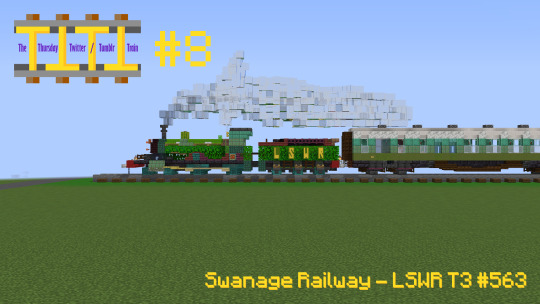
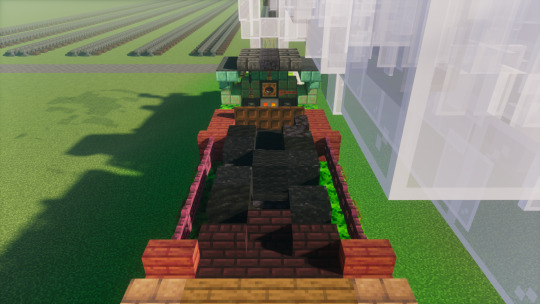





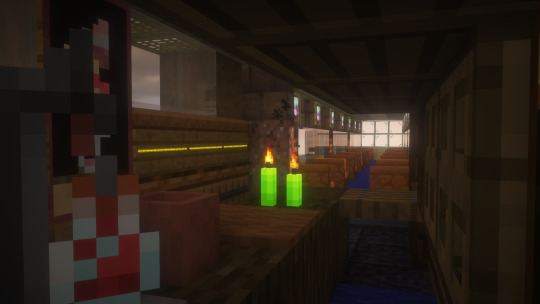

TTTT 8: The Swanage Railway's LSWR T3 #563, recently restored to run under her own power for the first time in 75 years! Complete with two ex-SR coaches and the "Devon Belle" Observation Car No. 14.
The latter of these has an incredibly storied history. After being retired from the SR's Devon Belle service, the LNWR-ambulance-turned-observation coach was towed behind Flying Scotsman on Alan Pegler's ill-fated tour of the US. Scotsman returned home soon thereafter, but the observation coach was left behind in San Francisco and attached to the side of an office building. The Swanage Railway bought #14 back in 2007, finally reuniting her with Scotsman on home turf in 2019.
#anyone for jungle leaf steam train?#minecraft trains#swanage railway#steam locomotive#mc shaders#lswr#lnwr#t3 class#southern railway
6 notes
·
View notes
Video
Four Marks by Treflyn Lloyd-Roberts
Via Flickr:
S15 506 rolls into Medstead and Four Marks having worked up the bank from Ropley. Locomotive: London and South Western Railway Urie Class S15 4-6-0 506. Location: Medstead and Four Marks station on the Mid-Hants Railway.
#S15#506#rolls#Medstead#Four#Marks#having#worked#up#bank#from#Ropley#steam#engine#loco#train#Locomotive#London#LSWR#South#Western#Railway#Urie#Class#4-6-0#Location#station#Mid-Hants#Hampshire#flickr
16 notes
·
View notes
Text
This is an appreciation post for 0-4-2 Tender Engines:


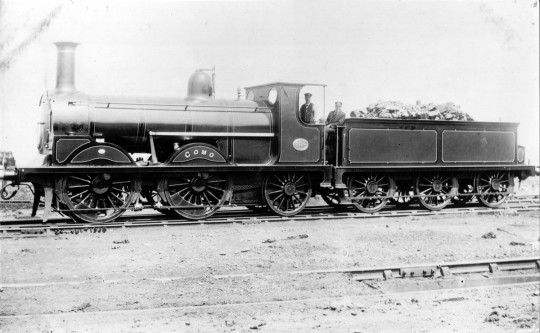




39 notes
·
View notes
Text

W19 Osbourne (still in it's LSWR livery) stops at Shanklin in the 1920's. Note the metropolitan carriages, some still in use today as beach huts along the Duver in St Helens.
Photographer Unknown.
#lswr#wightwanderer#shanklin#isle of wight#train#station#heritage#locomotive#history#line#photography#20s
1 note
·
View note
Text

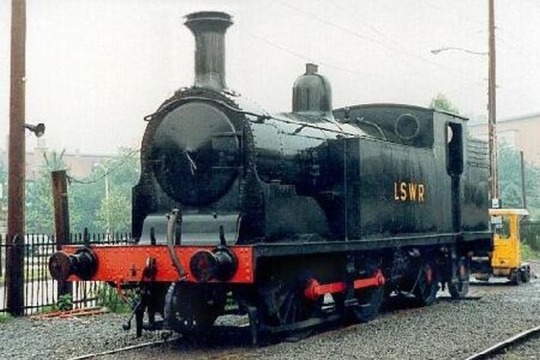

I really wanna make a model of 30053 in it’s American condition, Unlined black, Arial Font, incorrect number, red siderods, everything
1 note
·
View note
Video
London & South Western Railway - LSWR 2-4-0 steam locomotive Nr. 0100 PYTHON (Nine Elms Works, July 1868) by Historical Railway Images
Via Flickr:
London & South Western Railway Joseph Beattie “Centaur” series “Improved Clyde” class 7ft. 2-4-0 express passenger steam locomotive 100 PYTHON. It was built at Nine Elms in 1868, then reboilered and restyled by Adams in December 1888
0 notes
Text
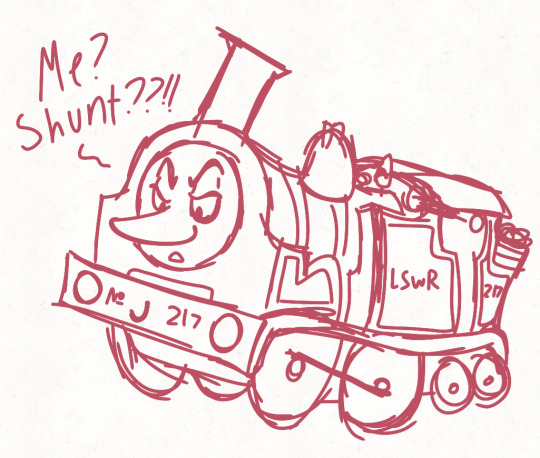
Drummond thinks he's far too important to do shunting
#i wanted to try drawing him angry and was pretty happy with the result!#drummond the pompous engine#thomas the tank engine#thomas and friends#ttte#ttte oc#oc#my art#lswr m7
12 notes
·
View notes
Text

Literally have not posted in forever buuuuuut here's two of my Thomas OCs humanized because I'm back in the hyperfixation for better or for worse.
If you're wondering what their irl basis is, they're supposed to be LSWR C14s but I can't draw trains for the life of me.
#yuriharu art#ocs#my ocs#my oc art#my oc stuff#my ocs <3#my oc drawing#thomas and friends#thomas the tank engine#thomas oc#thomas fanart#ttte#ttte humanized#t&f#humanization
12 notes
·
View notes
Video
Panning Practice por Treflyn Lloyd-Roberts
Por Flickr:
With the clouds having rolled in, it was time for something to pass the time... "Calbourne" heads past Ashey Common towards Havenstreet on the Isle of Wight Steam Railway during a Timeline Events photo charter. Locomotive: LSWR Adams O2 Class 0-4-4T W24 "Calbourne". Location: Ashey Common, Isle of Wight.
14 notes
·
View notes
Text

Presenting the LBSCR A1/A1x terriers! in 30 liveries.
Here is a list of the liveries and locos. They will be listed left to right, top to bottom.
1. Stepney in 1960s preservation/RWS condition IEG
-preserved irl
2. Kemptown in Original IEG (or close to it)
-She was sold to a colliery and preserved in the 70s
3. Martello in Southern Olive
-preserved irl
4. Abigail (Wandle) in AF&JR Blue
- @angryskarloey 's OC, see their fics for info
5. Freshwater in FYN Green
-preserved irl
6. Deptford in NER Green
-sold to a factory, survived the factory being bombed in 1915, was sold to the NER to replace a 'destroyed' E1 (Thomas in my AU), sold to the NWR in 1923
7. Minories in NWR Blue
-sold to the NWR in 1933
8. Carisbrooke in Southern Machalite
-bought for a Musuem in 1959
9. Nicola (Piccadilly) in AFJR Blue
-See @angryskarloey
10. Beulah in DWR Black, 2-4-0 condition
-purchased by the DWR in 1934, expirementally rebuilt back into a 2-4-0
11. Thomas (fictional addition) in NWR (rebuilt) Blue
-fictional addition to the class, just to have Thomas as a terrier
12. Cheapside in LB&SCR Umber with white lining
-purchased in 1951 at scrap price by Suddery Rail Museum after withdrawl due to broken crank axle, restored and serves as pilot at musuem. Livery was proven to be historically inaccurate, but She prefers it, so was allowed to keep it.
13. Brighton Works in Brighton Pilot livery
-Stolen by Caomhnóir in 1963, later restored by the Bluebell
14. Portishead in GWR Shirtbutton Green
-disappeared from Swindon in 1950, reappeared at the KESR in 1978
15. Ashted in WC&PR Green
-sold into industry, bounced around the NCB till the 80s, then purchased by the KESR in 1976
16. Fenchurch in LBSCR Umber
-Preserved irl
17. Bodiam (Popular) in KESR Blue 18. Sutton in Worn Grey
-Preserved irl
19. Waddon in SE&CR condition post-war Green
-Preserved irl
20. Boxhill in LBSCR 2-4-0 Condition IEG
-Preserved irl
21. Whitechappel in BR Lined Black
-Preserved irl
22. Clapham in LSWR Mint
-bought for spares for Kemptown. Purchased alongside kemptown and rebuilt in the 80s
23. Knowle in Southern Black
-Preserved irl
24. Newport in Isle of Wight Central Railway Red
-Preserved irl
25. Leadenhall in New Haven Harbor Co.
-purchased by the New Haven Harbor Co. to work alongside Fenchurch. Preserved direct from British Railways in 1962
26. Millwall In DWR rebuilt condition
Purchased by the DWR in 1934. Due to her boiler being little better than scrap condition, she was fited with a DWR D1 type boiler.
27. Zephyr (Wapping) in streamlined condition
-striped for parts to repair Popular in 1938, but her frames were saved by an eccentric Railway director, who loved the terriers. Rebuilt as his personal engine and given cosmetic streamlining, she was purchased from BR following his retirement, was stored in a dedicated room in his home until his death in the 80s, when she was donated to the Bluebell as per his will.
28. Earlswood in DWR 0-4-2 condition
-purchased by the DWR in 1949, experimentally rebuilt as an 0-4-2
29. Tooting in C&HR Blue
-Purchased by the C&HR in 1901 for service on a coastal branchline, which she still runs to this day.
30. Brixton in Caledonian Blue
-sold to a colliery in 1935, purchased by the Caledonian preservation Society in 64 to serve as a shunter in their works.
*collapses*
22 notes
·
View notes
Text
Internet…I need your help.
I want to make Lady something other then a tank engine for a series that I’m coming up with, but I’m stuck with what she should be.
@hazel-of-sodor gave me the idea of using one of William Adam’s engines with her use of the LSWR class 415. They have the right build dates I want plus they have the right style I want.
Does anyone have any other ideas?
#ttte#ttte lady#tumblr polls#ttte au#yes this is relating to that ‘engines and the narrator talk to each other’ post from months ago lol#I’ve been busy with college but I finally have a direction for it!
15 notes
·
View notes
Text
Edward/Edith The Blue Engine [NWR AU]

History
Edith was built in 1890 as LSWR No. 577 of William Adam's X2 Class 4-4-0s. She originally carried the name Edward, but as she made the choice to change genders, I will be referring to her as Edith throughout this post. She worked out of Nine Elms shed between 1891 and 1915 when she was purchased by the NWR to work their express trains. Upon arrival, she was stabled at Vicarstown with her colleague Thomas. By the end of the Great War in 1918, her parts were thoroughly worn out and the workload was far too much for her, so The Fat Director purchased an "Atlantic" from a relatively little-known works in England to run his premiere express trains while Edith went in for refurbishment. Unfortunately however, the engine he received (Henry) performed far worse than expected, forcing the refurbishment work on Edith to be halted as she was pressed back into service once again. She soldiered on until 1922, when the railway bought Gordon. After Gordon's purchase, the railway was strapped for cash, so she was left in the back of the shed until repairs could be afforded. Unfortunately, in all the postwar stress, The Fat Director forgot to schedule her repairs and she was left there until 1924, when a driver took pity on the already life-expired engine and offered to take her out for a run, after which she was sent for repairs where it was found that the tolerances on her motion had been worn down so much that there was near an eighth-inch of play. After the works had finished with her in 1925, she was practically in factory-fresh condition.
Her life following this was relatively uneventful, up until her re-assignment to the Brendam Branchline in 1936, soon after which she had to chase a runaway James along the mainline to prevent a derailment. During the Second World War, Brendam Harbour was constantly full to capacity and often got raided by the Luftwaffe, which once again meant that Edith was thrashed to breaking point. Her schedule was packed to the brim with troop trains from every corner of the island to Brendam Harbour. Being relatively fast as well as light, she was the perfect engine for the job.
After the war, she was once again worn out completely, which was not helped by the increase in traffic due to the completion of the Sodor China Clay Company's Bill & Ben. Due to postwar austerity, she wasn't overhauled until it was far too late. While on an enthusiast's special in 1959, she split her left crank pin, causing her con-rod to break free of her wheel, bending her frame and splashers out of shape. Never one to give up, she slogged the eight-coach train as far as Wellsworth before being relieved by Mark, who was working thunderbird duties at the time. After her exploit, she received a very hasty and very desperate apology from Sir Charles Topham Hatt II, who gave her a complete overhaul as soon as possible. After her overhaul, she met a lonely Trevor the Traction Engine while passing by Crock's Scrap Yard. After making her crew aware of him, the three decided to consult the local vicar, and after a few negotiations, he was bought for the vicarage orchard.
In 1962, The Fat Controller noticed that Edith was struggling to keep up with the workload alone, and so purchased a failed diesel locomotive design from British Railways. The pair first met when Bill and Ben decided to play a trick on the newcomer, having their crews remove their nameplates and pretend they were the same engine. After Edith scared them off, the two got to chatting. Edith and BoCo have been firm friends ever since.
In 1971, Edith (then still known as Edward) made the realisation that she did not and had never felt male. With the support of Sir Charles, she changed her name to Edith, Sir Charles even having new custom nameplates cast for her. It took the others some time to come around, but they eventually all accepted her decision. By 2017, Edith was 127 and was certainly feeling her age. She put in a request to Sir Stephen Topham Hatt to formally retire from revenue service. Her request was granted and she went on an island-wide farewell tour. After her retirement, she was purchased by Sir Robert Norramby II for his (formerly his father's) estate railway/museum, where she resides to this day.
Personality
Edith is a caring, sweet and thoughtful engine, often putting others before herself. Though admirable, her selflessness sometimes leads to self-neglect or damage. Though she's usually the go-to engine to talk about your issues to, she shares very little about her own. Despite her shortcomings, she is a joy to talk to and was an asset to the railway.
Thank you for reading, I'll see you in the next one.
Cheerio!
#ttte#steam engine#steam locomotive#ttte au#rws au#ttte headcanon#ttte edward#alt history#locomotive#trains#railway#rws
12 notes
·
View notes
Text
had the brilliant idea of "what if tender engines were tank engines and vice versa?"
anyways here's tank engine Edward. he can't hurt you. :3
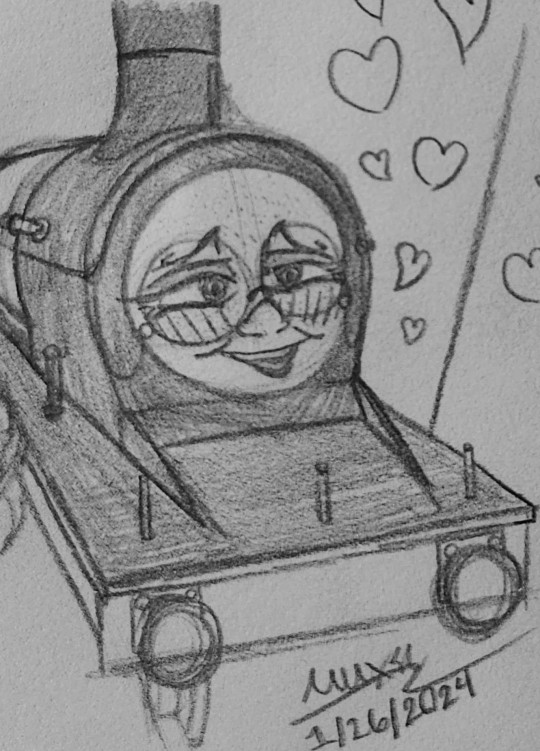
he's a Dublin, Wicklow and Wexford Railway (DW&WR) 52 class. only three of these were built. Chose these as they were built by Sharp Stewart Co in 1893. Since these are a different gauge, Edward was rebuilt to standard gauge or he was a commissioned build by one of the predecessors of the NWR, built in the 1890s.
Also it turns out that they also did heavy passenger work but struggled like the 21s did.


i COULD'VE made him an LSWR Adams Radial Tank engine but nah- this fits him better.
also you can't tell me that these DON'T look like the tank engine version of the FR 21s
7 notes
·
View notes
Photo

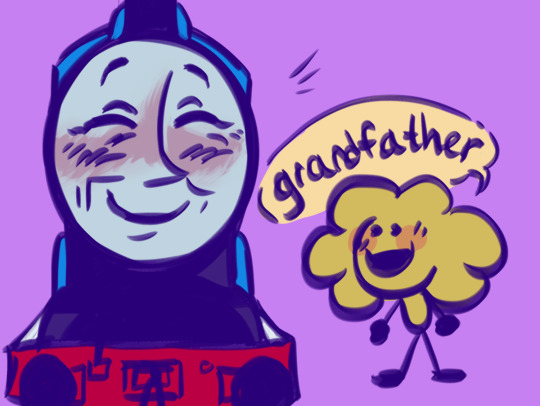
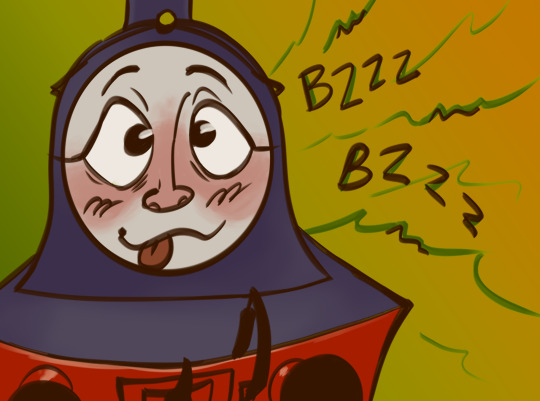


Abigail and Edward !!!
new basis for my s/i engine OC, she’s an LSWR F9 :-)


Hahaheehe
105 notes
·
View notes
Text
The time has come…
… for the full story of my engine OC, Violet, and how she got to Sodor!

(Drawing by @fraiserabbit!! Thanks again for that btw)
Strap in, folks, this’ll be a long one :)
The Beginning
Violet is an LSWR O2 Class tank engine, built in 1891, making her Old As Hell even by Sodor standards. She’s small, with four driving wheels, four trailing wheels, and two inside cylinders, and she bore the number 222. She and the other members of her class were made mainly to run commuter services between London and its suburbs, which Violet hated. The intense timetables and hectic pace made her very anxious, not helped by the fact that the Manager and Stationmasters put a lot of pressure on her to perform despite any mechanical issues or delays out of her control. Her quiet, nervous demeanor caused her first driver to call her a “shrinking violet”, and that became her name.
Fortunately for her, she was moved onto a much quieter branch line after just a few years. Violet really blossomed on the branch line. The more relaxed atmosphere gave her the chance to open up to others. Although she did still occasionally pull passenger trains on her new line, the job she loved most (and the one she’s still best at) was shunting. She became fast friends with the yard workers, who taught her songs and told her stories. When she was assigned passenger duties, she hummed the songs the workmen taught her as a way to keep herself calm and grounded. She lived and worked on the line for many years, making a great many friends in that time. Her class was widespread and long-lived, getting through the tail end of the Gauge War and surviving well past the Grouping. Her anxiety still got the best of her some days, because she is That Sort Of Engine, but she knew her friends would be there for her…
Until, one day, they weren’t.
Tucked Away
One day in 1933, the message came: Violet was to be withdrawn from service, and she would be scrapped. She was devastated by the news, and so were her friends, both engine and human. The workmen especially had grown very attached to their sweet old shunter, and so they came up with a plan to save her. There was an abandoned stretch of line some miles away, in a rural area that had been hit hard at the start of the Great Depression a few years earlier. Along that line was an empty engine shed. In the middle of the night, literal hours before she was to be taken for scrap, the workmen stole her away and drove her there. They wrapped her snugly in tarpaulins and promised her that they would come back when they’d found a new home for her.
None of them did.
They hadn’t meant to lie to her, but the lives of humans are complicated. The Depression took a toll on the railway, and cuts had to be made, including closing what was once Violet’s branch. Her friends had to go elsewhere to find work. Then, World War II happened. After all that, many of the former railwaymen were deceased, and the ones that weren’t were busy with families of their own. They forgot about the little old engine tucked away in that abandoned shed.
Violet was alone for 35 years.
She slept for a good portion of that time, but sometimes, she woke up, still alone. In those instances, she would sing the songs her friends had taught her long ago to comfort herself. The locals swore up and down that the singing came from a ghost, but it was only a lonely engine, waiting for the friends she’d known in days gone by.
One day in the spring of 1968, a small group of rail enthusiasts were exploring the area. One of their members, Jack Barton, had a grandfather who’d worked on the old lines when he was a young man, and the enthusiasts thought it would be fun to try and find out what, if anything, still remained there. The tracks that led to the abandoned yard were overgrown, but still there, and so the enthusiasts followed them. It wasn’t long before they could hear a voice, singing softly and mournfully through the brush and the mist. The more superstitious among them believed it was the ghost they’d heard tales about growing up. The more grounded ones thought it could be someone in need of rescue. It turned out they were all correct, in a way.
Finally Found
The enthusiasts were surprised to see an engine. The engine was just as surprised to see them. The tarpaulins that covered her were dusty and moth-eaten, moss and weeds were climbing through her wheels, her green paint was flaking and rusting, but she was there, alive. And one of the enthusiasts looked awfully familiar to her…
Jack’s grandfather, John Barton, was one of the workmen who hid Violet away. When the old man was told what they’d found, he insisted on seeing his engine friend despite his age, saying he needed to apologize to her. The grandson and grandfather made the trek through the brush, and although the conversation Violet and John had was long and difficult, it was much-needed. John and Jack swore to uphold the promise John made to her all those years ago, to finally find a home for her.
After that, the members of the enthusiast group began visiting her as often as they were able. They cleaned her up as best they could, taught her new modern songs, and told her about all the things that had happened in the world since she was shut away. Violet was happy not to be completely alone anymore, but also secretly doubtful that any place for her could be found, especially once she was told about diesel and electric locomotives.
She needn’t have worried about that, though.
A Special Visitor
A few months after Violet was found, Sir Topham Hatt received a letter from John, Jack, and the enthusiasts. The letter told Violet’s story, and ended with a plea for his help in finding a place for her. The Fat Controller was touched by their words, and he made arrangements to visit at once. He wanted to make sure she could be restored to working condition before giving a definite answer. To that end, he would be bringing along a pair of young engineers from the Crovan’s Gate Works, Gilbert “Gil” Jones and Sullivan “Sulley” O’Kelly, to assist in the assessment.
Violet’s new friends were very excited when they heard the news. In the days leading up to the visit, they brought copies of the Railway Series books to her shed and read them to her. She enjoyed hearing the stories, but couldn’t help but feel intimidated by the idea of actually meeting the Fat Controller. Sure, his railway was a haven for steam engines, but what would he want with her? She wasn’t like the engines from the stories. She wasn’t anything special. She didn’t make a daring escape like Oliver, Donald, or Douglas. She wasn’t unique like Toby. She didn’t have a significant legacy like Gordon. She’d certainly never done anything worth writing a book about, like Thomas, Edward, Henry, or James. And yet, Violet’s friends seemed so certain he would help her. They were over the moon about his visit and what it could mean, especially John and Jack. She didn’t want to take that away from them. So she kept her doubts to herself and put on a brave face for them.
Soon enough, the big day came. All of Violet’s friends were there, waiting for Jack and John to lead Sir Topham Hatt and his engineers to her shed. Violet was more nervous than she had been in ages. Her unexpressed doubts had turned to fear, and when she saw Jack, John, and the three Sudrians coming out of the woods, she froze up. She could barely manage a “hello” when the Fat Controller greeted her.
John immediately picked up on what was happening, and asked the others for a moment alone with her. Once the rest of the group were out of earshot, Violet told her old friend what was bothering her, and why she hid her feelings from him and the others. John assured her that she didn’t need to be anything other than the Really Useful Engine he knew her to be, and if anyone ever told her otherwise he would take them out at the knees with his cane. She felt much better after that, and once she was calmed down, Sir Topham Hatt, Gil, and Sulley began their examination.
As expected, time and stasis hadn’t exactly been kind to Violet’s body. However, it was determined that she was indeed repairable. It would take time and considerable effort, but Gil and Sulley were confident that it could be done. Sir Topham Hatt trusted their judgment, but before he could make his decision, he had one final question. He looked to Violet and asked her, “Once you are repaired, will you work hard?”
Her response was an emphatic “yes”.
It took about a year for Violet to be brought to Sodor. Aside from the logistics of physically moving Violet from her shed and onto the island, the fact that she’d been presumed scrapped since the 1930s meant that the North Western Railway’s lawyers had to work out the question of ownership before she could legally be considered one of their engines. In the meantime, Violet’s friends visited her at every opportunity. The day she could finally be moved to Sodor was a bittersweet one, but Sulley and Gil promised to send regular updates on her repairs to John and Jack, and they in turn promised to write letters to Violet as well. As a parting gift, the enthusiasts gave Violet a scrapbook full of photos of their time together, with plenty of room for more to be added in the future.
In the Works
It would turn out that, by sheer coincidence, another engine abandoned in an old shed and found by enthusiasts came into the Works at just about the same time Violet did. Duke and Violet became fast friends during their time at Crovan’s Gate, given their similar age and experiences. When they weren’t being worked on, the two old engines would swap stories and chat long into the night. Violet was grateful for his company. She felt lucky to have an engine friend to talk to who was going through the same things she was.
While doing research on Violet’s class, Gil and Sulley found out that Violet actually had one surviving sibling. Though Violet had known him as 209, his name was now Calbourne, and he lived on a heritage railway on the Isle of Wight. Violet was ecstatic at the news that her brother was still alive, and insisted on writing a letter to him. Getting in contact with Calbourne proved helpful, not only for the two engines’ morale, but also for the engineers working to restore them both. The teams could swap documents, photographs, and ideas in addition to the letters their engines dictated. Through their correspondence, the Crovan’s Gate team found out that Calbourne had been modified with a larger coal bunker and Westinghouse air brakes during his time on the Isle of Wight. It was decided that Violet would receive similar modifications. She was very pleased, as it meant that she would be just as Useful as her brother!
Unfortunately, John Barton passed away before Violet could be fully restored. She was heartbroken. It seemed like they had only just reconnected, and now he was gone for good. One of John’s last requests was to have some of his ashes sprinkled over Violet, and so Sir Topham Hatt gave Jack special permission to come to the Works in order to do that. Being an engine, Violet didn’t understand the significance of the ashes at first. When Jack explained that this was a way for a part of John to be with her forever, she was more than happy to let Jack put the ashes on her. Gil and Sulley helped him spread the ashes in places where they wouldn’t cause trouble later on, and after they’d finished, they gave him and Violet some space to mourn for a few hours. When it was time for Jack to leave, he told her that John was glad he got to see her again and fulfill his promise before he died. Violet was glad for that, too.
Into the Future
It took a little over a decade, but Violet’s restoration was finally complete. All that was left was for her to be painted. Sodor being Sodor, there is no standard livery. Instead, the Fat Controller asks each of his engines what color they would like to be painted. The question threw Violet for a bit of a loop, but she soon found her voice. She admitted that she’d always wanted to be painted, well, violet! The Fat Controller agreed that her choice was very fitting. So, she was painted a deep purple with green lining and a golden-yellow 222 on her tanks. When she was shown what she looked like in a mirror, she very nearly cried. She’d seen herself in the photos her mainland friends put in her scrapbook, and she didn’t like how she looked in them. Now, she looked at herself and saw a proper engine, one that John and all her LSWR friends would have been proud of. Finally, finally, she felt like she would be Useful again.
There was one more surprise for Violet. She had been assigned a crew, two men that the Fat Controller knew she would get along swimmingly with. He called them in… and Gil and Sulley stepped out, not wearing their normal coveralls, but the uniforms of the North Western Railway’s engine crews! The two had been training for the past few years, and the timing of their graduation to the footplate just so happened to work out with Violet’s return to service. (Or, at least, that’s what the pair told her. In reality they’d grown attached. She was their engine now, and they weren’t about to give her up that easily. Sir Topham Hatt suspected that this was the case, but didn’t say anything because these two were hard-working, reliable, and determined as hell, and besides, what better crew for an engine than one that literally and figuratively knew them inside and out?) Violet was elated! She was dreading having to say goodbye to them, and now she wouldn’t need to; she’d be working with them every day!
As Violet took her first wheel turns out of Crovan’s Gate Works and into the light of day, she was nervous, but excited. She’d been given so much, and now it was her turn to give back.
Who would she meet? What would she do? Where would she go?
Those, my friends, are stories for another day.
#ttte#ttte oc#thomas the tank engine#violet (oc)#my own writing#my own oc#if you read the whole thing: thank you!!#also please please please ask me questions about her
17 notes
·
View notes

